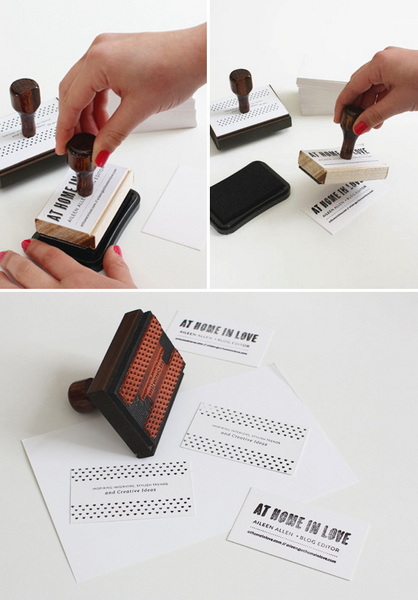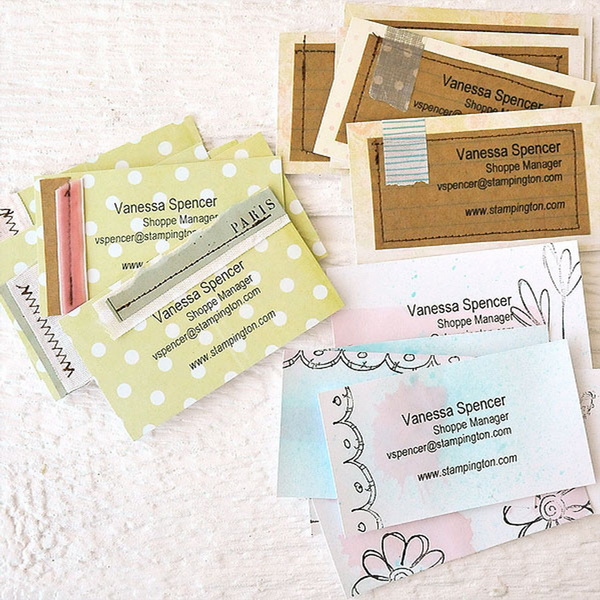Content Menu
● Materials and Tools You'll Need
● Designing Your Business Cards
>> Information to Include
>> Layout and Design Principles
>> Step-by-Step Design Process
● Printing Your Business Cards
>> Test Printing
>> Printing on Cardstock
>> Cutting Your Business Cards
● Adding Finishing Touches
● DIY Business Card Ideas
● Conclusion
● Frequently Asked Questions
>> 1. What Information Should I Include on My Business Card?
>> 2. What Type of Paper Should I Use for Business Cards?
>> 3. Can I Use Microsoft Word to Design Business Cards?
>> 4. How Can I Ensure My Business Cards Look Professional?
>> 5. What Are Some Creative DIY Business Card Ideas?
● Citations:
Creating your own business cards at home can be a cost-effective and creative way to represent your brand. Whether you're a freelancer, small business owner, or simply someone who enjoys DIY projects, designing and printing your own business cards offers a personal touch that can set you apart. This comprehensive guide will walk you through the process, from gathering materials to designing and printing your cards, ensuring a professional and unique result.

Materials and Tools You'll Need
Before you begin, gather all the necessary materials and tools. Having everything on hand will streamline the process and help you avoid unnecessary interruptions[1]. Here's a detailed list:
- Cardstock Paper: Choose a high-quality cardstock paper that feels substantial and looks professional. A weight of 80-110 lb is generally recommended[6][1]. You can find cardstock at most craft stores or online retailers.
- Printer: A laser printer is ideal for business cards because it produces crisp, smudge-free text and images[1]. However, an inkjet printer can also work, especially if you use inkjet-compatible cardstock. Ensure your printer can handle the thickness of the cardstock[1].
- Design Software: There are many options for designing your business cards, ranging from free online tools to professional design software[4]. Some popular choices include:
- Canva: A user-friendly online platform with a wide range of templates and design elements[2][9].
- Adobe Photoshop: A professional-grade image editing software that offers extensive customization options[4].
- Adobe Illustrator: A vector-based design software ideal for creating logos and intricate designs[5].
- Microsoft Word: A basic word processing program that can be used to create simple business cards[3][8].
- Shopify Business Card Maker: An automatic card designer that lets you skip the design guesswork[4].
- Cutting Tools: Accurate cutting is essential for achieving a professional look. You can use:
- Paper Cutter: A paper cutter provides clean, straight cuts and is ideal for cutting multiple cards at once[2].
- Exacto Knife and Cutting Mat: An exacto knife offers precision for intricate cuts, especially if you're adding decorative edges[1].
- Scissors: Scissors can be used for basic cutting, but they may not produce the cleanest edges[1].
- Ruler: A ruler is necessary for measuring and marking accurate cutting lines[1].
- Optional Embellishments: Depending on your design, you might want to add embellishments such as:
- Watercolors: For creating custom backgrounds or adding artistic touches[1].
- Stamps and Ink: For adding patterns or textures[3].
- Copper Foil or Gilding: For adding a touch of elegance[1].
- Stickers: For adding logos or decorative elements[1].
- Ribbons or Washi Tape: For adding a unique, handmade touch[3].
- Cricut: An electronic cutting machine that can be used for cutting precise shapes and designs[7].
Designing Your Business Cards
The design of your business cards is crucial because it represents your brand and makes a lasting impression. Consider the following elements when creating your design:
Information to Include
- Your Name: Essential for personal identification[7].
- Job Title or Position: Clarifies your role and expertise[7].
- Company Name: If applicable, include the name of your company[7].
- Contact Details: Include your phone number, email address, and business address[7].
- Website URL: Directs people to your online presence[7].
- Social Media Handles: Allows people to connect with you on social media platforms[7].
- Logo: A visual representation of your brand[7].
- Tagline: A brief statement that communicates your brand's value proposition[7].
- QR Code: A scannable code that directs people to your website or online portfolio[4].
Layout and Design Principles
- Choose a Template: Start with a business card template to save time and ensure a professional layout[4]. Many design software programs offer customizable templates[8].
- Brand Consistency: Use brand-relevant colors, fonts, and design elements to maintain a consistent brand identity[4].
- White Space: Leave enough white space to avoid a cluttered look and make the card easy to read[4].
- Font Choice: Select fonts that are legible and reflect your brand's personality. Use a maximum of two font styles to keep the design clean[4].
- Color Scheme: Use a color scheme that is visually appealing and aligns with your brand. Consider using a color palette generator to find complementary colors[4].
- Bleed Area: If you're using software like Photoshop, keep all important details within the bleed area to ensure they don't get cut off during printing[4].
Step-by-Step Design Process
1. Select Your Design Software: Choose the design software that best suits your skills and needs. Canva is a great option for beginners, while Adobe Photoshop and Illustrator offer more advanced features[2][4].
2. Choose a Template or Start from Scratch: Browse through the available templates or create your own design from scratch. If you're using a template, customize it with your own information and branding elements[4].
3. Add Your Information: Input all the necessary information, such as your name, job title, contact details, and website URL[8].
4. Incorporate Your Logo and Branding: Upload your logo and incorporate your brand colors and fonts into the design[4].
5. Add Visual Elements: Include relevant images, icons, or graphics to enhance the visual appeal of your business card[4].
6. Finalize the Design: Review your design carefully to ensure all the information is accurate and the layout is visually appealing[4].

Printing Your Business Cards
Once you've finalized your design, it's time to print your business cards. Here's how to ensure a successful print:
Test Printing
- Print a Test Sheet: Before printing a large batch, print a test sheet on plain paper to check the alignment and color accuracy. This will help you identify any issues and make necessary adjustments[4].
- Adjust Printer Settings: Adjust your printer settings to the highest quality and select the appropriate paper type (cardstock). This will ensure the best possible print quality[4].
Printing on Cardstock
1. Load the Cardstock: Load the cardstock into your printer's paper tray. Make sure the cardstock is properly aligned to prevent misprints[1].
2. Print in Batches: Print your business cards in batches to avoid overheating your printer. Allow the printer to cool down between batches if necessary[4].
3. Double-Sided Printing: If you're printing double-sided business cards, make sure your printer supports duplex printing. Align the front and back of the cards properly to ensure the information is aligned correctly[5].
Cutting Your Business Cards
Accurate cutting is essential for achieving a professional look. Follow these steps to cut your business cards:
1. Use a Paper Cutter: Place the printed sheet on a paper cutter and align the cutting line with the edge of the card. Cut along the line to create clean, straight edges[2].
2. Use an Exacto Knife: If you're using an exacto knife, place the printed sheet on a cutting mat. Use a ruler to guide the knife and cut along the lines. This method is ideal for intricate cuts and decorative edges[1].
3. Cut Carefully: Take your time and cut carefully to avoid jagged edges. A steady hand and sharp cutting tools are essential for achieving a professional result[1].
Adding Finishing Touches
Once your business cards are printed and cut, you can add finishing touches to enhance their appearance. Here are a few ideas:
- Edge Painting: Apply paint to the edges of your business cards for a pop of color[1].
- Foil Stamping: Add metallic foil to your logo or other design elements for a touch of elegance[1].
- Embossing: Create a raised effect on your business cards for a tactile and visual appeal[1].
- Rounded Corners: Use a corner rounder to create rounded corners for a softer look[1].
- Lamination: Laminate your business cards to protect them from wear and tear and give them a glossy finish[1].
DIY Business Card Ideas
Here are some creative DIY business card ideas to inspire you:
- Watercolor Business Cards: Create custom watercolor backgrounds for a unique and artistic look[1].
- Stamped Business Cards: Use rubber stamps and ink to add patterns and textures to your business cards[3].
- Handmade Paper Business Cards: Use handmade paper for a rustic and organic feel[3].
- Minimalist Business Cards: Create a clean and simple design with minimal information for a modern look[1].
- Die-Cut Business Cards: Use a die-cutting machine to create unique shapes and designs[7].
Conclusion
Making business cards at home allows for creativity and customization while saving money. By choosing the right materials, utilizing design software effectively, and paying attention to detail during printing and cutting, you can create professional-looking cards that represent your brand. Whether you opt for a minimalist design or incorporate artistic touches, the key is to create a card that is memorable and effectively communicates your identity.

Frequently Asked Questions
1. What Information Should I Include on My Business Card?
Your business card should include your name, job title, company name (if applicable), contact details (phone number, email address, business address), website URL, and social media handles[7]. A logo and tagline can also be added to enhance your brand identity[7].
2. What Type of Paper Should I Use for Business Cards?
Use high-quality cardstock paper with a weight of 80-110 lb for a professional feel[6][1]. Ensure your printer can handle the thickness of the cardstock[1].
3. Can I Use Microsoft Word to Design Business Cards?
Yes, you can use Microsoft Word to design simple business cards[3][8]. Search for business card templates within Word and customize them with your information and branding elements[8].
4. How Can I Ensure My Business Cards Look Professional?
To ensure your business cards look professional, pay attention to the design layout, font choices, and color scheme[4]. Use high-quality cardstock paper, print with a laser printer, and cut accurately with a paper cutter or exacto knife[1][2].
5. What Are Some Creative DIY Business Card Ideas?
Some creative DIY business card ideas include watercolor backgrounds, stamped patterns, handmade paper, minimalist designs, and die-cut shapes[1][3][7].
Citations:
[1] https://www.thesorrygirls.com/lifestyle/diy-business-cards
[2] https://www.youtube.com/watch?v=rlTcwouo4BQ
[3] https://stampington.com/create-your-own-business-cards/
[4] https://www.shopify.com/blog/make-business-cards-home
[5] https://www.reddit.com/r/DIY/comments/fy9s4s/diy_business_cards/
[6] https://www.youtube.com/watch?v=ipyiY72JTco
[7] https://www.instructables.com/Homemade-Business-Cards-with-a-Cricut/
[8] https://www.hihello.com/blog/how-to-make-a-business-card
[9] https://www.youtube.com/watch?v=mMtmxAoJ6D8
































